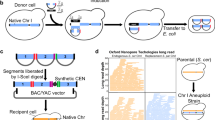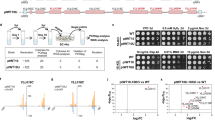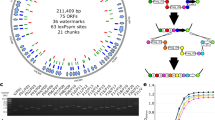Abstract
Circular yeast artificial chromosomes (YACs) provide significant advantages for cloning and manipulating large segments of genomic DNA in Saccharomyces cerevisiae. However, it has been difficult to exploit these advantages, because circular YACs are difficult to isolate and purify. Here we describe a method for purification of large circular YACs that is more reliable compared with previously described protocols. This method has been used to purify YACs up to 600 kb in size. The purified YAC DNA is suitable for restriction enzyme digestion, DNA sequencing and functional studies. For example, YACs carrying full-size genes can be purified from yeast and used for transfection into mammalian cells or for the construction of a synthetic genome that can be used to produce a synthetic cell. This method for isolating high-quality YAC DNA in microgram quantities should be valuable for functional and synthetic genomic studies. The entire protocol takes ∼3 d to complete.
This is a preview of subscription content, access via your institution
Access options
Subscribe to this journal
Receive 12 print issues and online access
$259.00 per year
only $21.58 per issue
Buy this article
- Purchase on Springer Link
- Instant access to full article PDF
Prices may be subject to local taxes which are calculated during checkout


Similar content being viewed by others
References
Burke, T. et al. Cloning of large segments of exogeneous DNA into yeast by means of artificial chromosome vectors. Science 236, 806–812 (1987).
McGonidal, T. et al. Construction of a human DNA library in a circular centromere-based yeast plasmid. Gene 155, 267–271 (1995).
Zeng, C. et al. New BAC/YAC libraries allowing to selectively re-isolate a desired genomic region by in vivo recombination in yeast. Genomics 77, 27–34 (2001).
Kouprina, N. et al. Functional copies of a human gene can be directly isolated by TAR cloning with a small 3′ end target sequence. Proc. Natl. Acad. Sci. USA 95, 4469–4474 (1998).
Shizuya, H. et al. Cloning and stable maintenance of 300-kilobase-pair fragments of human DNA in Escherichia coli using an F-factor-based vector. Proc. Natl. Acad. Sci. USA 89, 8794–8797 (1992).
Ioannou, P.A. A new bacteriophage P1-derived vector for the propagation of large human DNA fragments. Nat. Genet. 6, 84–89 (1994).
Smith, D.R. et al. Amplification of large artificial chromosomes. Proc. Natl. Acad. Sci. USA 87, 8242–8246 (1990).
Kouprina, N. & Larionov, V. Exploiting the yeast Saccharomyces cerevisiae for the study of the organization of complex genomes. FEMS Microbiol. Rev. 27, 629–649 (2003).
Kouprina, N. et al. Segments missing from the draft human genome sequence can be isolated by TAR cloning in yeast. EMBO Rep. 4, 257–262 (2003).
Leem, S.H. et al. Closing the gaps on human chromosome 19 revealed genes with a high density of repetitive tandemly arrayed elements. Genome Res. 14, 239–246 (2004).
Larionov, V. et al. Direct isolation of human BRCA2 gene by transformation-associated recombination in yeast. Proc. Natl. Acad. Sci. USA 94, 7384–7387 (1997).
Kouprina, N. & Larionov, V. TAR cloning: insights into gene function, long-range haplotypes and genome structure and evolution. Nat. Rev. Genet. 7, 805–812 (2006).
Benders, G.A. et al. Cloning whole bacterial genomes in yeast. Nucleic Acids Res. 38, 2558–2569 (2010).
Ebersole, T. et al. Rapid generation of long synthetic tandem repeats and its application for analysis in human artificial chromosome formation. Nucleic Acids Res. 33, e130 (2005).
Ayabe, F. et al. A novel expression system for genomic DNA loci using a human artificial chromosome vector with transformation-associated recombination cloning. J. Hum. Genet. 50, 592–599 (2005).
Iida, Y. et al. Human artificial chromosome with a conditional centromere for gene delivery and gene expression. DNA Res. 17, 293–301 (2010).
Gibson, D.G. et al. Complete chemical synthesis, assembly, and cloning of a Mycoplasma genitalium genome. Science 319, 1215–1220 (2008).
Gibson, D.G. et al. One-step assembly in yeast of 25 overlapping DNA fragments to form a complete synthetic Mycoplasma genitalium genome. Proc. Natl. Acad. Sci. USA 105, 20404–20409 (2008).
Gibson, D.G. et al. Creation of a bacterial cell controlled by a chemically synthesized genome. Science 329, 52–56 (2010).
Lartigue, C. et al. Creating bacterial strains from genomes that have been cloned and engineered in yeast. Science 325, 1693–1696 (2009).
Den Dunnen, J.T. et al. Reconstruction of the 2.4 Mb human DMD-gene by homologous YAC recombination. Hum. Mol. Genet. 1, 19–28 (1992).
Larionov, V. et al. Highly selective isolation of human DNAs from rodent-human hybrid cells as circular YACs by TAR cloning. Proc. Natl. Acad. Sci. USA 93, 13925–13930 (1996).
Devenish, R.J. & Newlon, C. Isolation and characterization of yeast ring chromosome III by a method applicable to other circular DNAs. Gene 18, 277–288 (1982).
Leem, S.H. et al. Purification of circular YACs from yeast for DNA sequencing. Genome 51, 155–158 (2008).
Kouprina, N. et al. Segments missing from the draft human genome sequence can be isolated by TAR cloning in yeast. EMBO Rep. 4, 257–262 (2003).
Acknowledgements
The research reported in this article was supported by Synthetic Genomics (SGI) (V.N.N., R.-Y.C. and D.G.G.) and by the intramural research program of the National Institutes of Health National Cancer Institute, Center for Cancer Research (V.L. and N.K.).
Author information
Authors and Affiliations
Contributions
V.N.N. and R.-Y.C. optimized and tested the protocols, generated the figures and cowrote the Procedure and Materials sections. D.G.G. developed topological trapping of circular DNA and worked on Troubleshooting. S.-H.L. suggested using the Qiagen construct kit for YAC purification. V.L. and N.K. suggested the use of alkaline lysis for large circular DNA purification from yeast and worked on the Abstract, Introduction, Experimental design and References sections.
Corresponding authors
Ethics declarations
Competing interests
The authors declare no competing financial interests.
Rights and permissions
About this article
Cite this article
Noskov, V., Chuang, RY., Gibson, D. et al. Isolation of circular yeast artificial chromosomes for synthetic biology and functional genomics studies. Nat Protoc 6, 89–96 (2011). https://doi.org/10.1038/nprot.2010.174
Published:
Issue Date:
DOI: https://doi.org/10.1038/nprot.2010.174
This article is cited by
-
Efficient de novo assembly and modification of large DNA fragments
Science China Life Sciences (2022)
-
Selective isolation of large segments from individual microbial genomes and environmental DNA samples using transformation-associated recombination cloning in yeast
Nature Protocols (2020)
-
COMPASS for rapid combinatorial optimization of biochemical pathways based on artificial transcription factors
Nature Communications (2019)
-
Recombinase-mediated cassette exchange (RMCE) system for functional genomics studies in Mycoplasma mycoides
Biological Procedures Online (2015)
-
Saccharomyces cerevisiae: a potential host for carboxylic acid production from lignocellulosic feedstock?
Applied Microbiology and Biotechnology (2014)
Comments
By submitting a comment you agree to abide by our Terms and Community Guidelines. If you find something abusive or that does not comply with our terms or guidelines please flag it as inappropriate.



